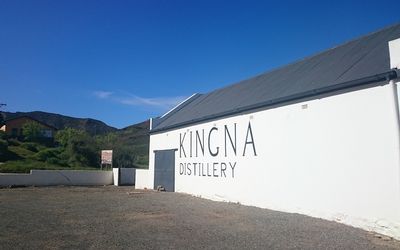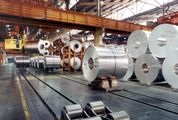VAN RYN’S 12-year-old Distillers Reserve competed with more than 7,000 entries and won the Worldwide Brandy trophy at the International Wine & Spirit Competition (IWSC) in London last year. It was the 12th time a local brandy had scooped the top prize in the past 15 years.
Part of the secret to the success is SA’s strict legislation, which ensures high-quality standards in production. And it all starts with high-quality wine.
"Wine-making for brandy is different to that for regular wine," says Ferdi Smit of Barrydale Cellar, whose Joseph Barry brandy won the trophy in 2009. "The first distillation takes about eight hours and turns base wine into low wine. The second distillation is where the heart of brandy-making takes place."
Quite literally, it seems. When the low wine is distilled, three parts emerge. The first is called the "head", and because it contains volatile alcohols, it is put back into the low wine for distillation again. The same happens to the "tail", the final part that is also unsuitable for use as is. What they’re aiming for is the "heart": a colourless output that is about 70% alcohol and matures in oak casks.
"All the grapes are grown in this area and they are picked much greener compared to normal wine," explains Smit of their use of Ugni Blanc (as the French do in Cognac) and Colombar varietals. "We also don’t add any sulphur because this reacts with the copper in the pot stills. We then leave the base wine on the lees (residual yeast and other particles that precipitate after fermentation), because that’s where a lot of the flavour comes from."
...
SMIT says that in addition to getting the right grapes, finding a skilled distiller is vital.
Unlike in a factory, where you push a button to get consistent results, making brandy is a hands-on, delicate process that requires exact timing. Get it right and you have the perfect output. Get it wrong and you ruin everything.
"At the height of production, our 1,000-litre pot stills would work for nine months of the year and distil about 30,000 litres of base wine for Distell," says Smit, who joined Barrydale Cellar in 1984. "But because of the downturn in brandy sales and consumption, there’s such a big surplus. That’s why we didn’t distil here this year."
The plan is to refurbish the distillery and resume on a smaller scale, producing four brandies in an underground facility that will also house a restaurant. But, as is the case with other distillers on the R62 "Brandy Route", it’s not about making money; it’s about creating fine brandies that speak to a passion for their craft.
"We started playing around with distilling in 2003," says Norbert Engel of Kingna, a name referring to the river that runs through Montagu, another small town in the Klein Karoo.
"We had a lot of product and decided to store it in vats. A few years later, we had customs and excise authorities knocking on our doors and telling us we were doing something illegal. They confiscated our pot still and gave us a fine."
Down but not defeated, Engel and distiller Ruan Hunlun decided to do things "the proper way".
They use Chenin Blanc and Colombar grapes and perform double distillation in their 2,800-litre pot still.
And, as per the legislative rules of pot-still brandy, they don’t use additives or preservatives.
"The transformation from a clear liquid to a brown liquid takes place in the barrels," Engel explains. "We use American and French oak barrels, but they are difficult to source at times."
As is the case at Barrydale Cellar, Kingna uses second-hand barrels. While new barrels might give maximum extraction to effect the colour of the brandy, older barrels don’t create an overpowering "woody" taste.
"A lot of effort goes into the process," Engel says of the five litres of wine that create one litre of brandy. "We are careful in how we handle the barrels. We ensure the cellar temperature is right to prevent unnecessary evaporation."
...
STILL, evaporation is bound to happen, especially because US oak grows quickly and is more porous than oak from France. Indeed, because the alcohol content is so high when the brandy is maturing in the casks, 3% of it evaporates every year.
Add to this the legalisation requirements that South African brandy matures untouched for at least three years, and a lot of the product disappears into thin air.
"We’re a small operation and it’s difficult to expand over time. We’d like to make a 20-year-old brandy one day, but we don’t want to deplete all our stocks," says Engel.
What makes it trickier is that, unlike other distillers, Kingna doesn’t mix brandies across different years. Instead, it blends from barrels of the same year, so the brandies are consistent.
And yet this isn’t something it promotes much, because labelling a five-year-old brandy with the year "2008" could create confusion for consumers who don’t realise that brandy doesn’t age like wine.
"A hundred percent of what’s in the barrel is what’s in the bottle," Engel says. "We don’t do any shortcuts. There are people in the industry who do that. But for us, it’s useless to entertain that idea. You might save in the short term, but you lose in the long term. And it’s a long-term process."
• To explore the 22 "Brandy Homes" in South Africa, visit SA Brandy Foundation Brandy Homes

The Kingna Distillery near Montagu in the Klein Karoo produces small volumes of brandy. Picture: EUGENE YIGA
VAN RYN’S 12-year-old Distillers Reserve competed with more than 7,000 entries and won the Worldwide Brandy trophy at the International Wine & Spirit Competition (IWSC) in London last year. It was the 12th time a local brandy had scooped the top prize in the past 15 years.
Part of the secret to the success is SA’s strict legislation, which ensures high-quality standards in production. And it all starts with high-quality wine.
"Wine-making for brandy is different to that for regular wine," says Ferdi Smit of Barrydale Cellar, whose Joseph Barry brandy won the trophy in 2009. "The first distillation takes about eight hours and turns base wine into low wine. The second distillation is where the heart of brandy-making takes place."
Quite literally, it seems. When the low wine is distilled, three parts emerge. The first is called the "head", and because it contains volatile alcohols, it is put back into the low wine for distillation again. The same happens to the "tail", the final part that is also unsuitable for use as is. What they’re aiming for is the "heart": a colourless output that is about 70% alcohol and matures in oak casks.
"All the grapes are grown in this area and they are picked much greener compared to normal wine," explains Smit of their use of Ugni Blanc (as the French do in Cognac) and Colombar varietals. "We also don’t add any sulphur because this reacts with the copper in the pot stills. We then leave the base wine on the lees (residual yeast and other particles that precipitate after fermentation), because that’s where a lot of the flavour comes from."
...
SMIT says that in addition to getting the right grapes, finding a skilled distiller is vital.
Unlike in a factory, where you push a button to get consistent results, making brandy is a hands-on, delicate process that requires exact timing. Get it right and you have the perfect output. Get it wrong and you ruin everything.
"At the height of production, our 1,000-litre pot stills would work for nine months of the year and distil about 30,000 litres of base wine for Distell," says Smit, who joined Barrydale Cellar in 1984. "But because of the downturn in brandy sales and consumption, there’s such a big surplus. That’s why we didn’t distil here this year."
The plan is to refurbish the distillery and resume on a smaller scale, producing four brandies in an underground facility that will also house a restaurant. But, as is the case with other distillers on the R62 "Brandy Route", it’s not about making money; it’s about creating fine brandies that speak to a passion for their craft.
"We started playing around with distilling in 2003," says Norbert Engel of Kingna, a name referring to the river that runs through Montagu, another small town in the Klein Karoo.
"We had a lot of product and decided to store it in vats. A few years later, we had customs and excise authorities knocking on our doors and telling us we were doing something illegal. They confiscated our pot still and gave us a fine."
Down but not defeated, Engel and distiller Ruan Hunlun decided to do things "the proper way".
They use Chenin Blanc and Colombar grapes and perform double distillation in their 2,800-litre pot still.
And, as per the legislative rules of pot-still brandy, they don’t use additives or preservatives.
"The transformation from a clear liquid to a brown liquid takes place in the barrels," Engel explains. "We use American and French oak barrels, but they are difficult to source at times."
As is the case at Barrydale Cellar, Kingna uses second-hand barrels. While new barrels might give maximum extraction to effect the colour of the brandy, older barrels don’t create an overpowering "woody" taste.
"A lot of effort goes into the process," Engel says of the five litres of wine that create one litre of brandy. "We are careful in how we handle the barrels. We ensure the cellar temperature is right to prevent unnecessary evaporation."
...
STILL, evaporation is bound to happen, especially because US oak grows quickly and is more porous than oak from France. Indeed, because the alcohol content is so high when the brandy is maturing in the casks, 3% of it evaporates every year.
Add to this the legalisation requirements that South African brandy matures untouched for at least three years, and a lot of the product disappears into thin air.
"We’re a small operation and it’s difficult to expand over time. We’d like to make a 20-year-old brandy one day, but we don’t want to deplete all our stocks," says Engel.
What makes it trickier is that, unlike other distillers, Kingna doesn’t mix brandies across different years. Instead, it blends from barrels of the same year, so the brandies are consistent.
And yet this isn’t something it promotes much, because labelling a five-year-old brandy with the year "2008" could create confusion for consumers who don’t realise that brandy doesn’t age like wine.
"A hundred percent of what’s in the barrel is what’s in the bottle," Engel says. "We don’t do any shortcuts. There are people in the industry who do that. But for us, it’s useless to entertain that idea. You might save in the short term, but you lose in the long term. And it’s a long-term process."
• To explore the 22 "Brandy Homes" in South Africa, visit SA Brandy Foundation Brandy Homes





















Change: 1.19%
Change: 1.36%
Change: 2.19%
Change: 1.49%
Change: -0.77%
Data supplied by Profile Data
Change: -0.08%
Change: 0.06%
Change: 1.19%
Change: 0.00%
Change: 0.03%
Data supplied by Profile Data
Change: -0.62%
Change: -0.87%
Change: -0.42%
Change: -0.51%
Change: -0.69%
Data supplied by Profile Data
Change: -0.90%
Change: 0.93%
Change: 0.19%
Change: 2.04%
Change: 1.02%
Data supplied by Profile Data